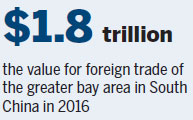Guangdong to get integration boost
Stocks leap after premier unveils plans to link areas
Shares of Guangdong-based port operators and developers surged by the daily limit on Wednesday, after Premier Li Keqiang said the central government will study and formulate an economic integration plan for the Guangdong-Hong Kong-Macao Greater Bay Area this year.
The companies include Zhuhai Port Co Ltd, Shenzhen Yantian Port Group Co Ltd, Gree Real Estate Co Ltd and Guangzhou Pearl River Industrial Development Holdings Co Ltd, while trading in some other stocks related to the area rallied strongly during the day.
Among the listed companies, the share price of Yantian Port rose 10.02 percent to close at 10.98 yuan ($1.59), and shares of Gree Real Estate surged 10.03 percent to 7.35 yuan.
The development plan for the area, with GDP totaling $1.4 trillion, along with a bond market connect plan between the mainland and Hong Kong to be launched this year, carries the goal of strengthening the cooperation between the mainland and Hong Kong and injects fresh momentum into Hong Kong's development, Li said when meeting Carrie Lam Cheng Yuet-ngor, newly elected chief executive of Hong Kong.
Li's remarks and the inclusion of the planning on the greater bay area in the Government Work Report, delivered by Li last month to the nation's legislature, indicated the vision is now being pushed forward, said Xiang Xiaomei, head of the Institute of Industrial Economics Research at the Guangdong Academy of Social Sciences.
The idea marked a shift from industrial to maritime and knowledge-based development, Xiang said.
In contrast to the cooperation featuring processing trade and industrial relocation from Hong Kong and Macao to Guangdong in the opening-up which started more than three decades ago, Guangdong-Hong Kong-Macao ties are set to become deeper, Xiang added.

Unlike the prominent bay areas in other parts of the world, this bay area in South China consists of three leading cities - Guangzhou, Shenzhen and Hong Kong. Because the plan involves Hong Kong and Macao, it therefore requires system coordination and innovation, Xiang said.
Although the planning has yet to be formulated, a report by Changjiang Securities Co noted this bay area includes nine cities in the Pearl River Delta region as well as Hong Kong and Macao, which jointly generated $1.8 trillion in foreign trade last year.
The development of this bay area should mean further economic integration and closer and greater people and cargo movement in the area, benefiting businesses related to ports, roads, airports and railways.
The building of the bay area should inject new impetus into the economies of cities such as Zhuhai, Shenzhen and Guangzhou, the report said.
He Ningka, director of the Guangdong Development and Reform Commission, suggested the development of such a bay area includes infrastructure connectivity and a global technological and industrial innovation center.
Wang Ting contributed to this story.
liwenfang@chinadaily.com.cn
(China Daily 04/13/2017 page13)


















